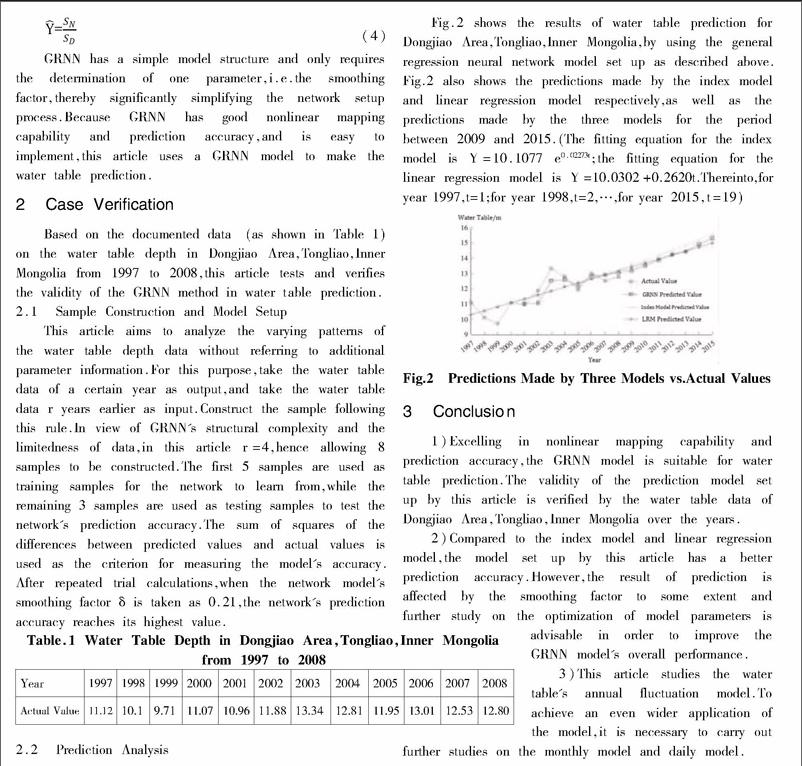Prediction of Water Table Based on General Regression Neural Network
GUAN+Shuai+QIAN+Cheng


【Abstract】Traditional methods for water table prediction have such defects as extensive calculation and reliance on the presupposition of a homogeneous and regular aquifer.Based on the fundamentals of the general regression neural network(GRNN),this article sets up a GRNN model for water level prediction.Case study indicates that this model, even with limited information,has satisfactory prediction accuracy,which,coupled with a simple model structure and relatively high calculation efficiency,mean a vast application prospect for the model.
【Key words】General regression neural network;Water table prediction;Index model;Linear regression
中圖分类号: P641.7 文献标识码: A 文章编号: 2095-2457(2017)35-0056-002
Water table is the elevation of the upper surface of water contained in the aquifer.As important aspects of water resources management,water table monitoring and prediction provide an important basis for urban planning and civil engineering design and construction,and is in itself a prerequisite to proper development and utilization of groundwater resources.Since the groundwater system is an important sub-system of the hydrological cycle,its hydrological connections with other water systems are rather complex.Fluctuations in the water table are not only subject to the effects of natural factors such as climate, atmospheric precipitation and surface water,but also closely related to human activities.All these influencing factors are intermingled with each other and result in a highly complex nonlinear characteristic of the water table fluctuation,adding to the difficulty of water table prediction.Traditionally,water table prediction is realized by establishing differential equation models for the groundwater flow.Applying this method however,requires the availability of valid hydrological and geological parameters;moreover,in most cases,influencing factors of water table vary significantly with time and location.As a result, calculations tend to be unsatisfactory due to data scarcity. For this reason,based on the water table monitoring data, this article conducts an inductive analysis of the available data by applying the general regression neural network method and obtains knowledge of the laws of internal evolution of the data, which can be used to predict future water tables.
1 Fundamentals of General Regression Neural Network
GRNN is a neural network model based on the nonlinear regression theory.As shown in Fig.1,the basic structure of GRNN consists of four layers:the input layer, the schema layer,the summation layer and the output layer.The network input X=[x1,x2,…,xn]T;accordingly,the network output is Y.endprint
Fig.1 Structure of a General Regression
Neural Network
The number of neurons on the input layer is equal to the dimension p of the input vectors in the learning samples.The number of neurons on the schema layer is equal to the number n of learning samples.Each neuron corresponds to different learning samples;for neuron i the transfer function is:
(1)
In the above formula,X is the network input variable; Xi is the learning sample to which neuron i corresponds. On the schema layer,each neuron corresponds to a training sample;the Gaussian function is regarded as a kernel function.On the summation layer,calculate the sum using two types of neurons respectively:
(2)
(3)
Then the network output
(4)
GRNN has a simple model structure and only requires the determination of one parameter,i.e.the smoothing factor,thereby significantly simplifying the network setup process.Because GRNN has good nonlinear mapping capability and prediction accuracy,and is easy to implement,this article uses a GRNN model to make the water table prediction.
2 Case Verification
Based on the documented data (as shown in Table 1) on the water table depth in Dongjiao Area,Tongliao,Inner Mongolia from 1997 to 2008,this article tests and verifies the validity of the GRNN method in water table prediction.
2.1 Sample Construction and Model Setup
This article aims to analyze the varying patterns of the water table depth data without referring to additional parameter information.For this purpose,take the water table data of a certain year as output,and take the water table data r years earlier as input.Construct the sample following this rule.In view of GRNN's structural complexity and the limitedness of data,in this article r=4,hence allowing 8 samples to be constructed.The first 5 samples are used as training samples for the network to learn from,while the remaining 3 samples are used as testing samples to test the network's prediction accuracy.The sum of squares of the differences between predicted values and actual values is used as the criterion for measuring the model's accuracy.After repeated trial calculations,when the network model's smoothing factor δ is taken as 0.21,the network's prediction accuracy reaches its highest value.
2.2 Prediction Analysis
Fig.2 shows the results of water table prediction for Dongjiao Area,Tongliao,Inner Mongolia,by using the general regression neural network model set up as described above.Fig.2 also shows the predictions made by the index model and linear regression model respectively,as well as the predictions made by the three models for the period between 2009 and 2015.(The fitting equation for the index model is Y=10.1077 e0.02273t;the fitting equation for the linear regression model is Y=10.0302+0.2620t.Thereinto,for year 1997,t=1;for year 1998,t=2,…,for year 2015,t=19)
Fig.2 Predictions Made by Three Models vs.Actual Values
3 Conclusion
1)Excelling in nonlinear mapping capability and prediction accuracy,the GRNN model is suitable for water table prediction.The validity of the prediction model set up by this article is verified by the water table data of Dongjiao Area,Tongliao,Inner Mongolia over the years.
2)Compared to the index model and linear regression model,the model set up by this article has a better prediction accuracy.However,the result of prediction is affected by the smoothing factor to some extent and further study on the optimization of model parameters is advisable in order to improve the GRNN model's overall performance.
3)This article studies the water table's annual fluctuation model.To achieve an even wider application of the model,it is necessary to carry out further studies on the monthly model and daily model.endprint

